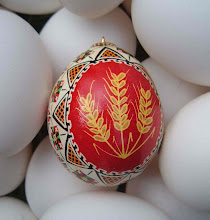In Northern Vermont the tomato disease we most often get is septoria leaf spot (as in the picture above), a fungus that lives in the soil and splashes up on plants, and is transmitted through the air, too. The disease starts with yellowing lower leaves, then brown spots that appear and eventually merge together, and the leaves turn brown and dry up. By the end of the summer we may have few leaves left on plants. Without leaves the plant can't produce sugars, and the tomatoes become excessively acid and don't have the complex flavors we enjoy.
Unlike the blight we had last summer, leaf spot doesn't generally directly affect the tomatoes. They can still be picked and eaten, but they won't have the great flavor a homegrown tomato should have, and the plants won't be as productive as they could be.
We can do several things at planting time to minimize or delay the onset of this and other fungal diseases. Although the fungal spores are in the air, the plants are subjected to a heavy load when rain splashes up on the plants from below. So anything we can do to minimize that will be helpful.
1) Removing the lower leaves keeps them from getting the disease early. For this reason I tend to plant tall plants without burying the stem extra deep, which is an old-time practice to maximize the root growth. I'd rather feed and water the existing root ball well.
2) Just about any mulch will help, if it protects the plant from splash-up from watering or rain. Straw will add organic matter eventually. But plastic mulches work too, and red plastic mulch may help productivity. I've put a clear plastic bag over the plant at planting time (by cutting a slit in the bottom seam), then inserted my cage, and had a bag I could pull up and attach to the cage, preventing even side splash, and helping to warm the plant on cold days. Weeds will grow under the clear plastic, and I take the bags off around July 1. If you have lots of compost or composted manure, you can top dress with it, which will protect the plant from soil splash but may also have disease-prevention properties on its own, as some have reported that spraying with compost tea or manure tea will prevent disease.
3) Help the plant stay dry. Water gently with a hose at the bottom of the plant, rather than watering overhead. Don't grow your plants too closely together. Alternatively, you can prune so there isn't a lot of excess foliage, especially at the bottom.
4) Do as much as you can to give the plant a strong immune system, by feeding well and spraying with a sea weed extract. Don't let the plant dry out to the point of serious wilting. Water deeply to encourage deep roots that will stay hydrated when the surface of the soil dries out.
5) If you have a serious problem with a fungal disease, you can spray with a fungicide which may prevent the disease or treat it. Update: The Vermont Department of Agriculture has a new brochure discussing late blight and how to minimize the likelihood you'll get it in your garden. Some of the listed fungicides (including those for organic programs) are very toxic to the applicator (you). Use all the product label's suggested precautions when using any fungicide or pesticide, and in general use only when the air is calm, wear long pants and a long sleeved shirt, and remove your clothes and shower after applying. Wouldn't hurt to wear a mask or respirator, too. The brochures are available at Claussens locally, and hopefully at other garden centers. The same fungicides listed for late blight would also work for the septoria leaf spot we get every year. I will still plan to use serenade, alternating with a copper fungicide, if necessary, both listed on organic programs. The leading chemical fungicide may be safer to apply, but some sites have implicated it in the aberrant changes in amphibians that are happening worldwide, so I'll avoid it.
Last year's blight will hopefully not reappear. It will have died with any organic material that didn't live over the winter. Potatoes sometimes survive the winter if they haven't been found when digging. In fact, I maintained a small crop of blue potatoes for a few years just this way. But it will be very important this year to pull out any potatoes that sprout from last year (and dispose in the trash, not the compost heap), as the blight could have survived the winter in the tubers. As you can see in the picture below, the blight affected the tomatoes and not just the foliage, and destroyed them in just a few days. Most organic growers in the Northeast lost all their tomatoes, and commercial growers needed to use a very strong fungicide to save their crop. Some isolated plots were unaffected.. I sprayed my plants just as soon as the blight appeared, and the sun gold cherry tomatoes survived with practically no damage. This is as good a reason as any to grow them.





No comments:
Post a Comment